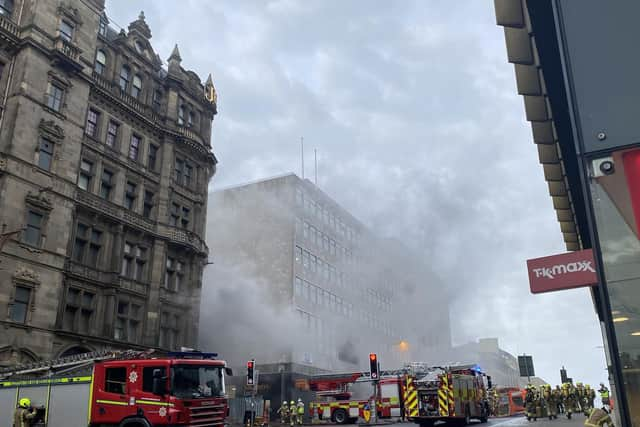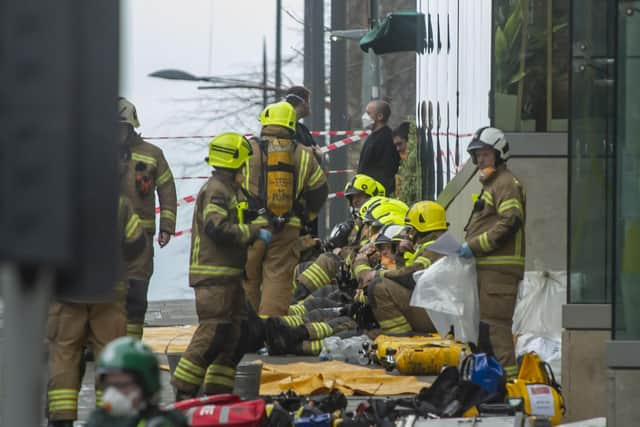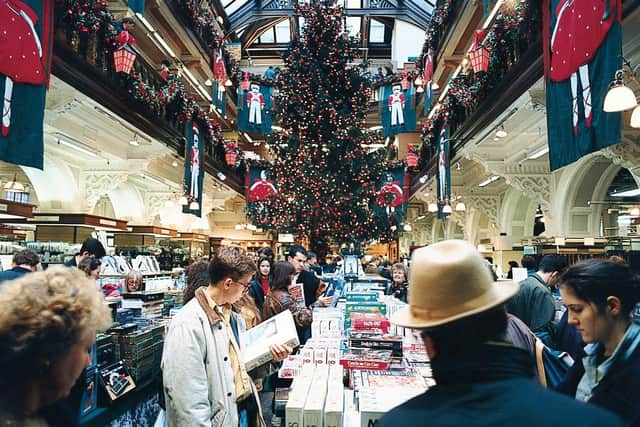Jenners fire Edinburgh: Five firefighters hospitalised as crews tackle ‘very serious’ blaze at Edinburgh landmark
At its peak, nearly two dozen appliances were on site as crews battled flames emerging from the listed building’s lower floors onto the street level, with thick black smoke pouring out of former department store. Some 11 appliances, together with other specialist resources, remained at the scene at 5.30pm.
Ross Haggart, the Scottish Fire and Rescue Service’s (SFRS) interim chief officer, described the fire as a “very serious and complex incident.” He said five of his colleagues had been taken to hospital for treatment. One was in in a “critical” condition, Mr Haggart added.
Advertisement
Hide AdAdvertisement
Hide AdThe Fire Brigades Union confirmed five firefighters were treated at the scene or at hospital, adding that one was in “a serious condition”.
Video footage circulated on social media appeared to show two SFRS crew members helping one of their colleagues out of the Jenners building via a South St David Street exit. The firefighter appeared to be covered in black soot, and unable to walk unaided.
Firefighters were called to the rear of the empty building on Rose Street shortly before 11.30am, where they discovered the structure was “well alight”. The extent of the damage to the building, owned by a holding company controlled by Anders Holch Povlsen, Scotland’s biggest private landowner, remained unclear on Monday night.
Since being vacated by Mike Ashley’s Frasers Group in 2021, the building has lain empty, but Mr Povlsen’s firm successfully applied last year to renovate the building as part of a £105 million project to create a boutique hotel as well as retail space and food and drink offerings. Those plans included a major overhaul of the building’s fire safety, including new escape stairwells and a sprinkler system. It is not known if any of those works had been carried since planning approval was granted in June last year.
Technical documents filed alongside the planning application by Mr Povlsen’s firm, AAA United, noted the fire strategy will be developed to comply with section two of the Building (Scotland) Regulations. The documents state: “Currently, the existing building does not meet these standards and requires interventions, most notably a new firefighting core.”


The cause of the fire remains unclear, and it is not yet known the extent of the damage across the Jenners site, which spans almost 17,500sqm across nine floors. The SFRS were alerted at 11.29am. A spokesman said the service initially mobilised two appliances to the scene, before a further eight appliances, including a high reach, were despatched. By early afternoon, a total of 22 appliances and other specialist resources were on site.
The incident caused disruption in the city centre, with several nearby buildings evacuated and some Princes Street businesses, including Marks and Spencer and the Mercure Hotel, closing early.
Several roads and footways were closed, including South St David Street, St Andrew Square, George Street at St Andrew Square, and Rose Street. The City of Edinburgh Council said the closures could remain in place for a “few days” while structural assessments are carried out.
Advertisement
Hide AdAdvertisement
Hide AdEyewitnesses said they saw significant amounts of smoke emerging from the building. Charlie Douglas, assistant manager of Festival Village at Waverley Mall, said he went outside after hearing sirens to see around eight fire engines. “You couldn’t see from the side of the pavement to the other,” he said. “The smoke was all coming up and it went on for quite a while. It was quite a scary situation, really.”


Oliver Lamprey, an on-street ticket seller for McGill’s Bright Bus Tours, described the smell of the smoke as “plasticky” and “woody”. One shopper, Terri Campbell, visiting the capital from South Ayrshire, said she got off a bus near the store to see “smoke everywhere” and “a lot of emergency services” around 12.40pm.
Donald Anderson, the former leader of the City of Edinburgh Council, said it appeared the “grand old dame” of the Jenners building had sustained “internal injuries” as a result of the fire, but expressed confidence it could be saved. “It’s certainly got the right owner to restore it,” he said.
Save Britain’s Heritage, a charity that campaigns to safeguard endangered historic buildings, said it was “shocked and concerned” to learn of the fire.
Planner Graham Marchbank said the sight of the building “up in smoke” raised questions. “Have lessons not been learned then since the Glasgow School of Art fire?” he asked.


It had been expected the building would reopen in 2025 after the works by AAA United, which acquired the site for a reported £53m in 2017. The project was to have retained the building’s facade, while making significant alterations elsewhere, including a seventh floor to the extension on the corner of South St David Street and Rose Street. The lower part of the building, which appeared to be hit worst by the fire, was earmarked as a retail space, complete with food and drink outlets.
At the time the plans were unveiled, Anders Krogh Vogdrup, AAA United’s director, said the project was “first and foremost about helping to preserve a unique and historic Edinburgh landmark”. He explained: “We are pursuing the project due to our drive and passion for architecture and historical buildings. This project seeks to secure the future of the Jenners building for generations to come.”
Historic Environment Scotland were among those to welcome the firm’s vision, stating it would “retain the significance and revitalise the use of Edinburgh's best known department store”, while also safeguarding the future use of the building at a time of retail transition.
Advertisement
Hide AdAdvertisement
Hide AdWhen the Jenners store closed for good in May 2021 after Frasers Group was unable to reach an agreement with AAA United on the extension of a tenancy deal, it signalled the end of an era for retail in the capital.
Jenners originally occupied former townhouses on the Princes Street and South St David Street site in 1838, but the building was destroyed by a fire in November 1892, paving the way for the department store building that became a fixture of Edinburgh city centre.
Inspired by Bon Marche and other European counterparts, architect William Hamilton Beattie designed it in the Victorian renaissance revival style, complete with twinned pilasters, caryatids and strapwork decoration. When it opened on March 8, 1895, predating the Harrods and Selfridges stores in London, it offered a brand new retail experience, offering everything from furniture and haberdashery through to cutting edge fashion.
An extension was added to the north side of the building up to Rose Street in 1903 by Beattie’s chief assistant, Andrew Robb Scott. In the 1920s, Jenners acquired neighbouring buildings on Princes Street, further expanding its footprint.
Additional extensions to the building were added in the 1950s and 1960s. Come 1970, the structure was designated as a listed building, with the category – A – signifying its importance.